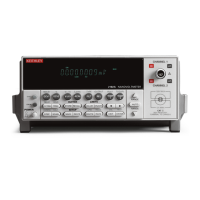12-4 Common Commands
*ESE <NRf> – Event Enable Program the standard event enable register
*ESE? – Event Enable Query Read the standard event register
Parameters
<NRf> = 0 Clear register
1 Set OPC (B0)
4 Set QYE (B2)
8 Set DDE (B3)
16 Set EXE (B4)
32 Set CME (B5)
64 Set URQ (B6)
128 Set PON (B7)
255 Set all bits
Description
Use the *ESE command to program the Standard Event Enable Register. This command is
sent with the decimal equivalent of the binary value that determines the desired state (0 or 1) of
the bits in the register. This register is cleared on power-up.
This register is used as a mask for the Standard Event Register. When a standard event is
masked, the occurrence of that event will not set the Event Summary Bit (ESB) in the Status
Byte Register. Conversely, when a standard event is unmasked (enabled), the occurrence of that
event sets the ESB bit. For information on the Standard Event Register and descriptions of the
standard event bits, see the following section.
A cleared bit (0) in the enabled register prevents (masks) the ESB bit in the Status Byte
Register from setting when the corresponding standard event occurs. A set bit (1) in the enable
register allows (enables) the ESB bit to set when the corresponding standard event occurs.
The Standard Event Enable Register is shown in Figure 12-1 and includes the decimal weight
of each bit. The sum of the decimal weights of the bits that you wish to be set is the parameter
value that is sent with the *ESE command. For example, to set the CME and QYE bits of the
Standard Event Enable Register, send the following command:
*ESE 36
Where: CME (bit B5) = Decimal 32
QYE (bit B2) = Decimal
4
<NRf> = 36

